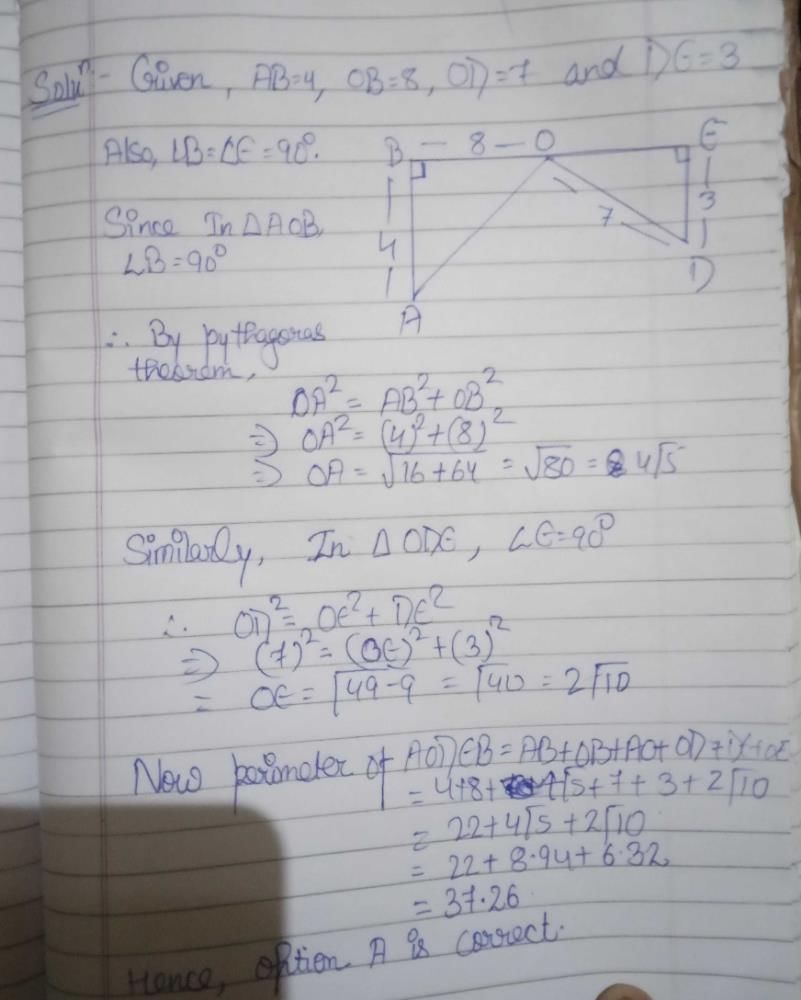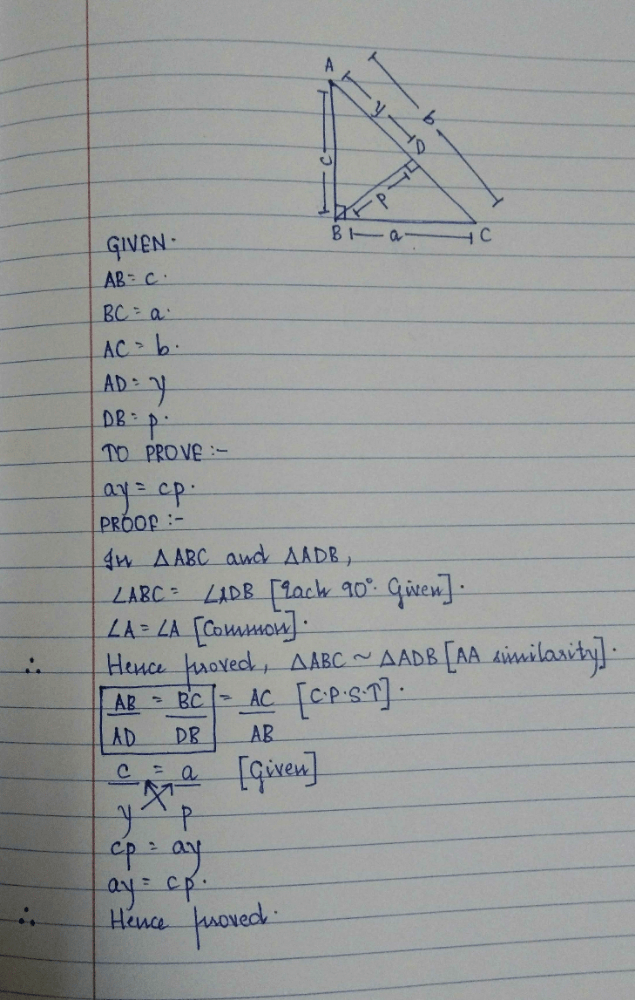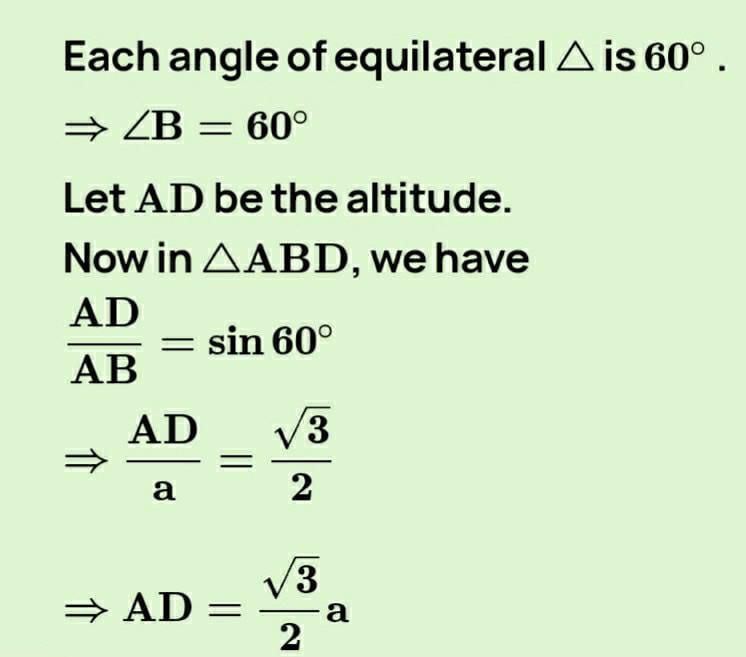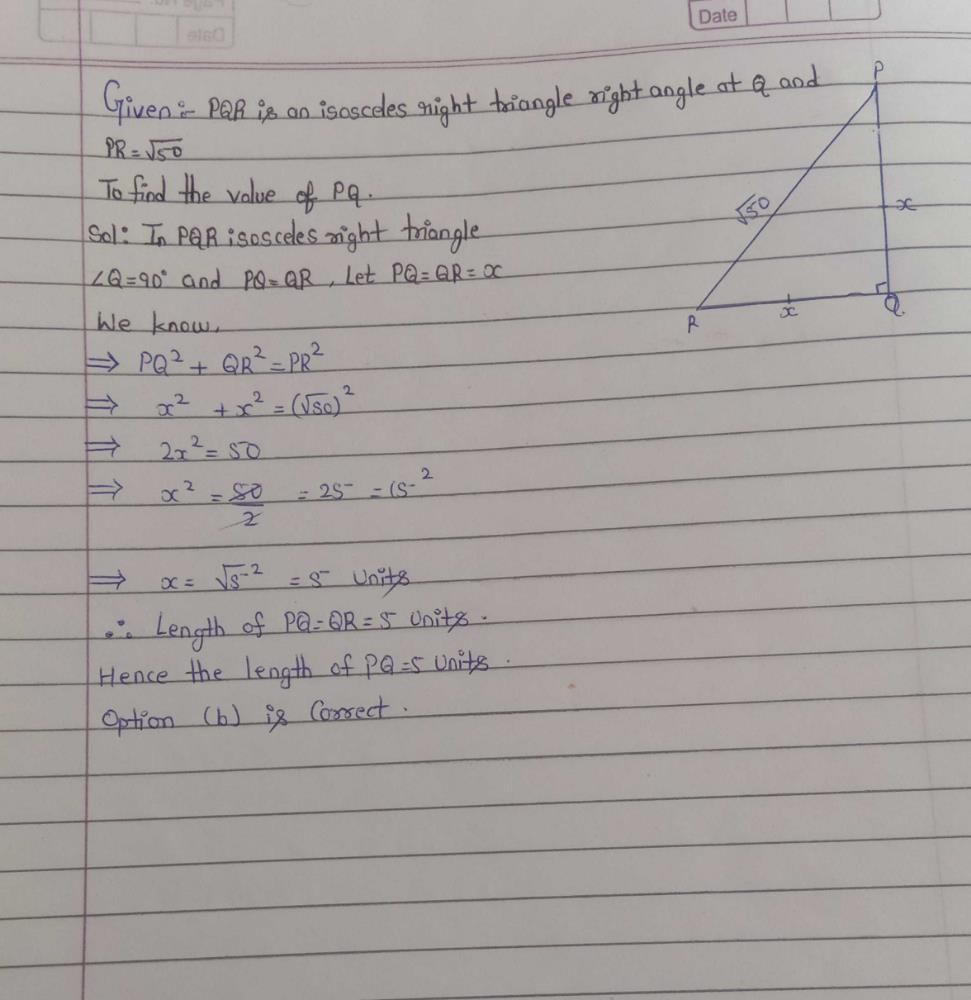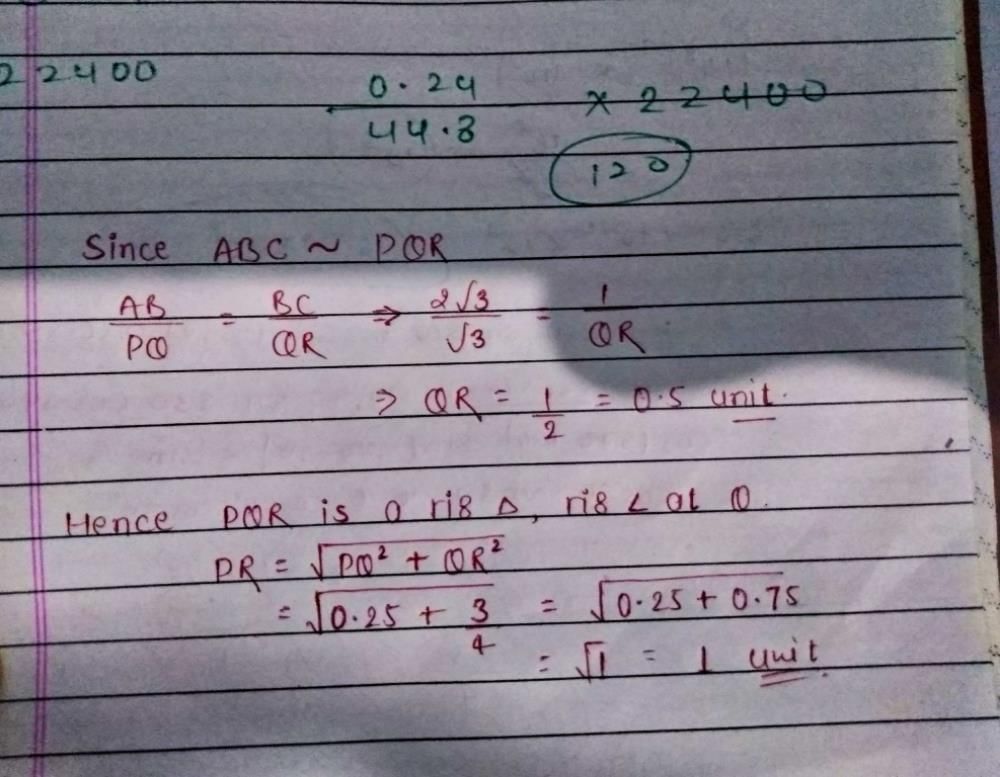All Exams >
Grade 10 >
Mathematics for Grade 10 >
All Questions
All questions of Pythagoras' Theorem for Grade 10 Exam
QM ⊥ RP and PR2 – PQ2 = OR2 . If∠QPM = 30° , Then ∠MQR is
- a)45°
- b)60°
- c)90°
- d)30°
Correct answer is option 'D'. Can you explain this answer?
QM ⊥ RP and PR2 – PQ2 = OR2 . If∠QPM = 30° , Then ∠MQR is
a)
45°
b)
60°
c)
90°
d)
30°
|
|
Krishna Iyer answered |
In triangle PMQ
Angle M = 90°
Angle P = 30°
Angle QMP + Angle MPQ + Angle PQM = 180 degree ( By angle sum property )
90 + 30 + Angle PQM = 180
Angle PQM = 180 - 120
Angle PWM = 60 Degree
QM divides Angle PQR into two equal parts .
Therefore Angle MQR = 30°
Angle M = 90°
Angle P = 30°
Angle QMP + Angle MPQ + Angle PQM = 180 degree ( By angle sum property )
90 + 30 + Angle PQM = 180
Angle PQM = 180 - 120
Angle PWM = 60 Degree
QM divides Angle PQR into two equal parts .
Therefore Angle MQR = 30°
From the given figure, find the unknown x.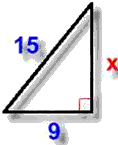
- a)12
- b)225
- c)10
- d)144
Correct answer is option 'A'. Can you explain this answer?
From the given figure, find the unknown x.
a)
12
b)
225
c)
10
d)
144
|
|
Ishan Choudhury answered |
Since the triangle is a right angled triangle,
Applying Pythagoras Theorem,
H2=P2+B2
152=P2+92
P2=225-81=144
P=12
Applying Pythagoras Theorem,
H2=P2+B2
152=P2+92
P2=225-81=144
P=12
What is the diagonal length of a TV screen whose dimensions are 80 x 60 cm?- a)10
- b)100
- c)20
- d)1000
Correct answer is option 'B'. Can you explain this answer?
What is the diagonal length of a TV screen whose dimensions are 80 x 60 cm?
a)
10
b)
100
c)
20
d)
1000
|
|
Pooja Shah answered |
We have a TV which is a rectangle whose adjacent sides form an angle of 90 degrees so The triangle formed by the two sides and a diagonal will be a right angle. So, Applying Pythagoras Theorem,
(Diagonal)2=802+602=6400+3600=10000
Diagonal=100cm
(Diagonal)2=802+602=6400+3600=10000
Diagonal=100cm
In a triangle ABC, AC= √180 ,AB=6 ,BC=12 .What is ∠B = ?- a)90°
- b)30°
- c)45°
- d)60°
Correct answer is option 'A'. Can you explain this answer?
In a triangle ABC, AC= √180 ,AB=6 ,BC=12 .What is ∠B = ?
a)
90°
b)
30°
c)
45°
d)
60°
|
|
Naina Sharma answered |
We have AB2=36 and BC2=144
Adding both the squares we get
AB2+BC2=36+144=180
=AC2
So , AC is the hypotenuse according to pythagoras theorem , So the angle opposite to it which is B is 90 degrees.
Adding both the squares we get
AB2+BC2=36+144=180
=AC2
So , AC is the hypotenuse according to pythagoras theorem , So the angle opposite to it which is B is 90 degrees.
Which of the following is a Pythagorean triplet ?- a)(36,18,43)
- b)(15,20,25)
- c)(3,12,13)
- d)(24,25,26)
Correct answer is option 'B'. Can you explain this answer?
Which of the following is a Pythagorean triplet ?
a)
(36,18,43)
b)
(15,20,25)
c)
(3,12,13)
d)
(24,25,26)
|
|
Vikram Kapoor answered |
A Pythagorean triple consists of three positive integers a, b, and c, such that a² + b² = c².
a) 432 = 1849
362+182 = 1620
b) 252 = 625
152 + 202 =625
c) 132 = 169
32 + 122 = 153
d) 262 = 676
242 + 252 = 1201
so option b is correct
How far up a wall will an 11m ladder reach, if the foot of the ladder is 4m away from the wall?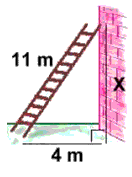
- a)121 m
- b)10 m
- c)10.2 m
- d)16 m
Correct answer is option 'C'. Can you explain this answer?
How far up a wall will an 11m ladder reach, if the foot of the ladder is 4m away from the wall?
a)
121 m
b)
10 m
c)
10.2 m
d)
16 m
|
|
Gaurav Kumar answered |
The height of wall will be the perpendicular for the right angle triangle. So applying pythagoras theorem
H2=P2+B2
11*11=P2+16
P=121-16=10.2 cm
H2=P2+B2
11*11=P2+16
P=121-16=10.2 cm
Which of the following cannot be the sides a right triangle?- a)400mm, 300 mm, 500mm
- b)9 cm, 15 cm, 12 cm
- c)2 cm, 1 cm, √5 cm
- d)9 cm, 5 cm, 7cm
Correct answer is option 'D'. Can you explain this answer?
Which of the following cannot be the sides a right triangle?
a)
400mm, 300 mm, 500mm
b)
9 cm, 15 cm, 12 cm
c)
2 cm, 1 cm, √5 cm
d)
9 cm, 5 cm, 7cm
|
|
Arun Sharma answered |
H2 = P2 + B2
H2 = 81
P2 + B2 = 25 + 49 = 74
H2 ≠ P2+B2.Therefore the sides cannot form a right triangle.
H2 = 81
P2 + B2 = 25 + 49 = 74
H2 ≠ P2+B2.Therefore the sides cannot form a right triangle.
The monitors of computers are measured along the diagonal. What is the size of the largest monitor that can be placed in a space measuring 17″ x 21″?- a)28″
- b)25″
- c)26″
- d)27″
Correct answer is option 'D'. Can you explain this answer?
The monitors of computers are measured along the diagonal. What is the size of the largest monitor that can be placed in a space measuring 17″ x 21″?
a)
28″
b)
25″
c)
26″
d)
27″
|
|
Kiran Mehta answered |
Since monitors are measured along the diagonals this means we need to use pythagoras theorem for this right angled triangle.
H2 = P2 + B2
=17 * 17 + 21 * 21
=289 + 441 = 730
H=27’’ (Approx)
H2 = P2 + B2
=17 * 17 + 21 * 21
=289 + 441 = 730
H=27’’ (Approx)
In right triangled ABC right angled at B ,a line DE is drawn through the mid point D of AB and parallel to BC.If AB=9 cm, BC=12 cm. AE=?- a)13 cm
- b)10 cm
- c)8.5 cm
- d)7.5 cm
Correct answer is option 'D'. Can you explain this answer?
In right triangled ABC right angled at B ,a line DE is drawn through the mid point D of AB and parallel to BC.If AB=9 cm, BC=12 cm. AE=?
a)
13 cm
b)
10 cm
c)
8.5 cm
d)
7.5 cm
|
|
Pooja Shah answered |
In a triangle ABC in which angle B = 90 degree
So, AB is height of the given triangle = 9 cm
Base of triangle i.e, BC = 12 cm
DE is || to BC
D is the mid point of side AB and E is the mid point of side AC
By applying pythagoras
AC2 = AB2 + BC2
AC2 = 9^2 + 12^2
AC2 = 81 + 144
AC2 = 225
AC = root under 225
AC = 15 cm
E is the mid point of AC
Therefore AE = AC / 2
AE = 15 / 2
AE = 7.5 cm
So, AB is height of the given triangle = 9 cm
Base of triangle i.e, BC = 12 cm
DE is || to BC
D is the mid point of side AB and E is the mid point of side AC
By applying pythagoras
AC2 = AB2 + BC2
AC2 = 9^2 + 12^2
AC2 = 81 + 144
AC2 = 225
AC = root under 225
AC = 15 cm
E is the mid point of AC
Therefore AE = AC / 2
AE = 15 / 2
AE = 7.5 cm
A wood frame for pouring concrete has an interior perimeter of 14 metres. Its length is one metre greater than its width. The frame is to be braced with twelve-gauge steel cross-wires. Assuming an extra half-metre of wire is used at either end of a cross-wire for anchoring, what length of wire should be cut for each brace?- a)14 m
- b)4 m
- c)6 m
- d)60 m
Correct answer is option 'C'. Can you explain this answer?
A wood frame for pouring concrete has an interior perimeter of 14 metres. Its length is one metre greater than its width. The frame is to be braced with twelve-gauge steel cross-wires. Assuming an extra half-metre of wire is used at either end of a cross-wire for anchoring, what length of wire should be cut for each brace?
a)
14 m
b)
4 m
c)
6 m
d)
60 m
|
|
Raghav Bansal answered |
Let width is x
Then length is x+1
Perimeter =x +x + x + 1 + x + 1 = 14
4 x= 12
x = 3
length = 4
Using Pythagoras theorem,
H2 = P2 + B2
=9 + 16 = 25
H = 5cm
An extra half meter on either side will give the length of the wire as 5 + 1 = 6cm
Then length is x+1
Perimeter =x +x + x + 1 + x + 1 = 14
4 x= 12
x = 3
length = 4
Using Pythagoras theorem,
H2 = P2 + B2
=9 + 16 = 25
H = 5cm
An extra half meter on either side will give the length of the wire as 5 + 1 = 6cm
If the sum of the length of the legs of a right triangle is 49 cm and the hypotenuse is 41 cm, find its shortest side.- a)19 cm
- b)40 cm
- c)4 cm
- d)9 cm
Correct answer is option 'D'. Can you explain this answer?
If the sum of the length of the legs of a right triangle is 49 cm and the hypotenuse is 41 cm, find its shortest side.
a)
19 cm
b)
40 cm
c)
4 cm
d)
9 cm
|
|
Amit Kumar answered |
Sum of the length of the legs of a right angle triangle is 49
So let one leg be x, other will be 49-x
Applying Pythagoras theorem,
H2=P2+B2
41*41=x2+(49-x)2
1681=x2 + 2401 + x2 - 98x
2x2- 98x + 720 = 0
Dividing the equation by 2
x2 - 49x + 360 = 0
x2 - 9x - 40x + 360 = 0
x (x - 9) - 40 (x - 9) = 0
(x - 9)(x - 40) = 0
So x is either 9 or 40,
So the smaller side is 9 cm
So let one leg be x, other will be 49-x
Applying Pythagoras theorem,
H2=P2+B2
41*41=x2+(49-x)2
1681=x2 + 2401 + x2 - 98x
2x2- 98x + 720 = 0
Dividing the equation by 2
x2 - 49x + 360 = 0
x2 - 9x - 40x + 360 = 0
x (x - 9) - 40 (x - 9) = 0
(x - 9)(x - 40) = 0
So x is either 9 or 40,
So the smaller side is 9 cm
Three squares are based on the sides of a right angled triangle. The area of the two smaller ones are 144 sq. cm and 256 sq. cm. What is the area of the third one?- a)625 sq. cm
- b)361 sq. cm
- c)400 sq. cm
- d)900sq. cm
Correct answer is option 'C'. Can you explain this answer?
Three squares are based on the sides of a right angled triangle. The area of the two smaller ones are 144 sq. cm and 256 sq. cm. What is the area of the third one?
a)
625 sq. cm
b)
361 sq. cm
c)
400 sq. cm
d)
900sq. cm
|
|
Swati Malkani answered |
Option C is correct
If the legs of an isosceles right triangle are 5 cm long, approximate the length of the hypotenuse to the nearest whole number.- a)9 cm
- b)7 cm
- c)70 cm
- d)90 cm
Correct answer is option 'B'. Can you explain this answer?
If the legs of an isosceles right triangle are 5 cm long, approximate the length of the hypotenuse to the nearest whole number.
a)
9 cm
b)
7 cm
c)
70 cm
d)
90 cm
|
|
Nisha Choudhury answered |
Isosceles means both legs have the same length, 5 in.
Pythagorean theorem:
5^2+ 5^2= h^2
25 + 25 = h^2
50 = h^2
√(50) = h
7.07 = h
round to whole number; h = 7
Find the height of the given triangle if its base is 26 inches and the slant side is 15 inches long as shown below.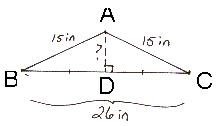
- a)7.48 inches
- b)19.8 inches
- c)29 inches
- d)9 inches
Correct answer is option 'A'. Can you explain this answer?
Find the height of the given triangle if its base is 26 inches and the slant side is 15 inches long as shown below.
a)
7.48 inches
b)
19.8 inches
c)
29 inches
d)
9 inches
|
|
Arun Sharma answered |
Height of the triangle is the altitude. SInce the triangle is an isosceles triangle its median is equal to its altitude . So this means that the altitude is perpendicular and bisects the opposite side .
So BD=DC=26/2=13
So in right angled Triangle,
Using Pythagoras theorem,
H2 = P2 + B2
225 = P2 + 169

So BD=DC=26/2=13
So in right angled Triangle,
Using Pythagoras theorem,
H2 = P2 + B2
225 = P2 + 169

Two friends A and B start from the same point in the Eastern and Northern directions at the same time. How far are they from each other when A has travelled 5 km and B has travelled 12 km. distance?- a)8 km
- b)17 km
- c)10 km
- d)13 km
Correct answer is option 'D'. Can you explain this answer?
Two friends A and B start from the same point in the Eastern and Northern directions at the same time. How far are they from each other when A has travelled 5 km and B has travelled 12 km. distance?
a)
8 km
b)
17 km
c)
10 km
d)
13 km
|
|
Abhishek answered |
When you construct the figure , you will get an right angled triangle, where height is 5 km and base is 12 km, ! Now how far they are far from each other, that would be given by the length of hypotenuse
putting Pythagoras theorem,
hypotenuse^2 = height^2 + base^2
Hypotenuse^2 = 5^2 + 12^2
Hypotenuse^2 = 169
Hypotenuse = √169 = 13 km
therefore they are 13 km away from each other
putting Pythagoras theorem,
hypotenuse^2 = height^2 + base^2
Hypotenuse^2 = 5^2 + 12^2
Hypotenuse^2 = 169
Hypotenuse = √169 = 13 km
therefore they are 13 km away from each other
What is the diagonal length of a TV screen whose dimensions are 80 cm x 60 cm?
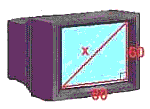
- a)10 cm
- b)1000 cm
- c)100 cm
- d)20 cm
Correct answer is option 'C'. Can you explain this answer?
What is the diagonal length of a TV screen whose dimensions are 80 cm x 60 cm?
a)
10 cm
b)
1000 cm
c)
100 cm
d)
20 cm
|
|
Priyanshu Intelligent answered |
Here , it is a right angled triangle -
Therefore, x = √[(80)^2 + (60)^2]
x = √[6400+3600]
x = √(10000)
x = 100 .
Hence , length of diagonal = 100 cm
If the sum of the squares of a and b is the same as the square of c and if m < n, then for what value of k can the Pythagorean triples be generated with the following equations?
a = n2 + k , b = 2mn : c = m2 + n2- a)m2
- b)m
- c)– m2
- d)-n2
Correct answer is option 'C'. Can you explain this answer?
If the sum of the squares of a and b is the same as the square of c and if m < n, then for what value of k can the Pythagorean triples be generated with the following equations?
a = n2 + k , b = 2mn : c = m2 + n2
a = n2 + k , b = 2mn : c = m2 + n2
a)
m2
b)
m
c)
– m2
d)
-n2

|
Angel answered |
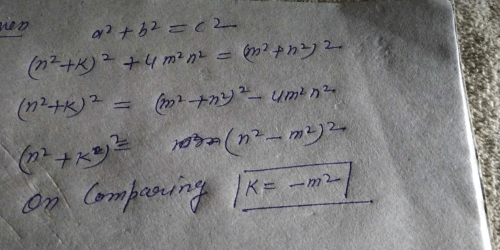
Three numbers form a Pythagorean triplet. Two of them are 15 and 17 where 17 is the largest of them. The third number is- a)8
- b)12
- c)13
- d)5
Correct answer is option 'A'. Can you explain this answer?
Three numbers form a Pythagorean triplet. Two of them are 15 and 17 where 17 is the largest of them. The third number is
a)
8
b)
12
c)
13
d)
5
|
|
Kajal verma answered |
Solution:
Pythagorean triplet is a set of three positive integers such that the sum of the squares of the two smaller integers is equal to the square of the largest integer.
Given, two numbers are 15 and 17 where 17 is the largest of them.
Let the third number be x.
Therefore, according to the Pythagorean triplet,
(17)^2 = (15)^2 + x^2
289 = 225 + x^2
x^2 = 289 - 225
x^2 = 64
x = 8
Hence, the third number is 8, which is option A.
HTML representation:
Pythagorean triplet is a set of three positive integers such that the sum of the squares of the two smaller integers is equal to the square of the largest integer.
Given, two numbers are 15 and 17 where 17 is the largest of them.
Let the third number be x.
Therefore, according to the Pythagorean triplet,
(17)^2 = (15)^2 + x^2
289 = 225 + x^2
x^2 = 289 - 225
x^2 = 64
x = 8
Hence, the third number is 8, which is option A.
HTML representation:
Solution:
Pythagorean triplet is a set of three positive integers such that the sum of the squares of the two smaller integers is equal to the square of the largest integer.
Given, two numbers are 15 and 17 where 17 is the largest of them.
Let the third number be x.
Therefore, according to the Pythagorean triplet,
(17)^2 = (15)^2 + x^2
289 = 225 + x^2
x^2 = 289 - 225
x^2 = 64
x = 8
Hence, the third number is 8, which is option A.
A boy is trying to catch fish sitting at a height of 12 m from the surface of the water. A big fish is at a horizontal distance of 5 m from him. What should be the length of his string to get the fish?- a)10
- b)13
- c)7
- d)15
Correct answer is option 'B'. Can you explain this answer?
A boy is trying to catch fish sitting at a height of 12 m from the surface of the water. A big fish is at a horizontal distance of 5 m from him. What should be the length of his string to get the fish?
a)
10
b)
13
c)
7
d)
15
|
|
Abhî answered |
Apply Pythagoras theorem :
12^2 + 5^2 = x^2
144 + 25 = x^2
169 = x^2
13 = x
12^2 + 5^2 = x^2
144 + 25 = x^2
169 = x^2
13 = x
Anuj swims across a pool diagonally every day. The pool is 4 m wide, and it is 16 m diagonally across. What is the length of the pool?
- a)16.49
- b)14.14 m
- c)15.49
- d)12.14 m
Correct answer is option 'C'. Can you explain this answer?
Anuj swims across a pool diagonally every day. The pool is 4 m wide, and it is 16 m diagonally across. What is the length of the pool?
a)
16.49
b)
14.14 m
c)
15.49
d)
12.14 m
|
|
Lucifer answered |
You can clearly see the base angle is 90, hence it's forming a right angled triangle! let's find out the base which will be considered as the length of pool
putting Pythagoras theorem,
Hypotenuse^2 = Base^2 + Height^2
16^2 = Base^2 + 4^2
256 = Base^2 + 16
Base^2 = 256 - 16
Base^2 = 240
Base = √240 = 15.49 approx
putting Pythagoras theorem,
Hypotenuse^2 = Base^2 + Height^2
16^2 = Base^2 + 4^2
256 = Base^2 + 16
Base^2 = 256 - 16
Base^2 = 240
Base = √240 = 15.49 approx
Chapter doubts & questions for Pythagoras' Theorem - Mathematics for Grade 10 2025 is part of Grade 10 exam preparation. The chapters have been prepared according to the Grade 10 exam syllabus. The Chapter doubts & questions, notes, tests & MCQs are made for Grade 10 2025 Exam. Find important definitions, questions, notes, meanings, examples, exercises, MCQs and online tests here.
Chapter doubts & questions of Pythagoras' Theorem - Mathematics for Grade 10 in English & Hindi are available as part of Grade 10 exam.
Download more important topics, notes, lectures and mock test series for Grade 10 Exam by signing up for free.
Mathematics for Grade 10
137 videos|83 docs|44 tests
|

Contact Support
Our team is online on weekdays between 10 AM - 7 PM
Typical reply within 3 hours
|
Free Exam Preparation
at your Fingertips!
Access Free Study Material - Test Series, Structured Courses, Free Videos & Study Notes and Prepare for Your Exam With Ease

 Join the 10M+ students on EduRev
Join the 10M+ students on EduRev
|

|
Create your account for free
OR
Forgot Password
OR
Signup to see your scores
go up within 7 days!
Access 1000+ FREE Docs, Videos and Tests
Takes less than 10 seconds to signup

